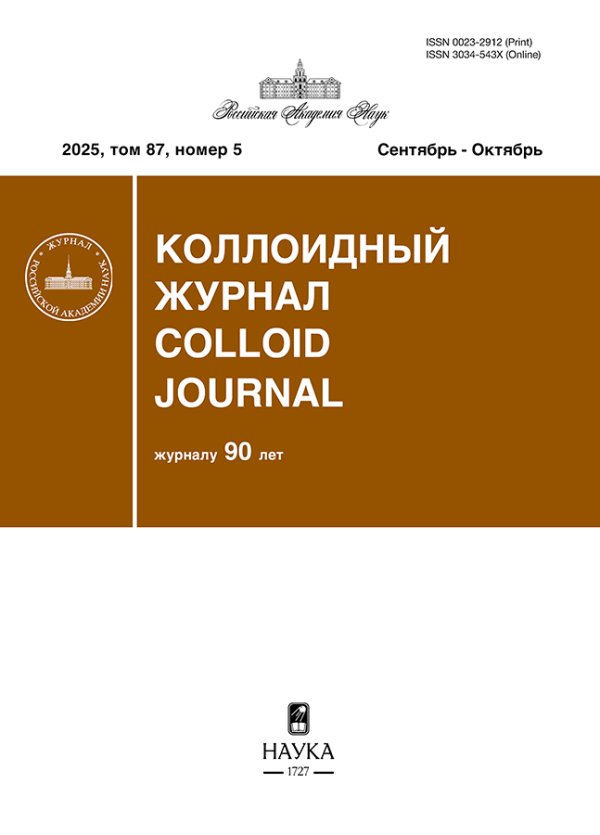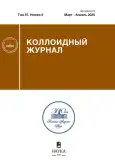TEMPERATURE-DEPENDENT WETTABILITY OF CONDUCTIVE FILMS BASED ON ELECTROPHORETIC SILVER NANOPARTICLE CONCENTRATES
- Authors: Babashova S.I.1, Bocharov V.V.1, Sulyaeva V.S.1, Maksimovskiy E.A.1, Kolodin A.N.1, Bulavchenko A.I.1
-
Affiliations:
- Institute of Inorganic Chemistry named after A.V. Nikolaev, Siberian Branch of the Russian Academy of Sciences
- Issue: Vol 87, No 2 (2025)
- Pages: 89-100
- Section: Articles
- Submitted: 18.08.2025
- Published: 15.03.2025
- URL: https://journals.rcsi.science/0023-2912/article/view/304827
- DOI: https://doi.org/10.31857/S0023291225020014
- EDN: https://elibrary.ru/tpktbq
- ID: 304827
Cite item
Abstract
Keywords
About the authors
S. I. Babashova
Institute of Inorganic Chemistry named after A.V. Nikolaev, Siberian Branch of the Russian Academy of Sciences3 Lavrentiev Avenue, Novosibirsk, 630090 Russia
V. V. Bocharov
Institute of Inorganic Chemistry named after A.V. Nikolaev, Siberian Branch of the Russian Academy of Sciences3 Lavrentiev Avenue, Novosibirsk, 630090 Russia
V. S. Sulyaeva
Institute of Inorganic Chemistry named after A.V. Nikolaev, Siberian Branch of the Russian Academy of Sciences3 Lavrentiev Avenue, Novosibirsk, 630090 Russia
E. A. Maksimovskiy
Institute of Inorganic Chemistry named after A.V. Nikolaev, Siberian Branch of the Russian Academy of Sciences3 Lavrentiev Avenue, Novosibirsk, 630090 Russia
A. N. Kolodin
Institute of Inorganic Chemistry named after A.V. Nikolaev, Siberian Branch of the Russian Academy of Sciences
Email: kolodin@niic.nsc.ru
3 Lavrentiev Avenue, Novosibirsk, 630090 Russia
A. I. Bulavchenko
Institute of Inorganic Chemistry named after A.V. Nikolaev, Siberian Branch of the Russian Academy of Sciences3 Lavrentiev Avenue, Novosibirsk, 630090 Russia
References
- Fernandes I.J., Aroche A.F., Schuck A., et al. Silver nanoparticle conductive inks: synthesis, characterization, and fabrication of inkjet-printed flexible electrodes // Scientific Reports. 2020. V. 10. № 1. P. 8878. https://doi.org/10.1038/s41598-020-65698-3
- Sreenilayam S.P., McCarthy É., McKeon L., et al. Additive-free silver nanoparticle ink development using flow-based laser ablation synthesis in solution and aerosol jet printing // Chemical Engineering Journal. 2022. V. 449. P. 137817. https://doi.org/10.1016/j.cej.2022.137817
- Mo L., Guo Z., Yang L., et al. Silver nanoparticles based ink with moderate sintering in flexible and printed electronics // International Journal of Molecular Sciences. 2019. V. 20. № 9. P. 2124. https://doi.org/10.3390/ijms20092124
- Iram N., Khan S.N., Ahmed M., et al. Synthesis and characterizations of silver nanoparticles-based conductive ink for high-frequency electronics // Physica Scripta. 2024. V. 99. № 8. P. 0859a8. https://doi.org/10.1088/1402-4896/ad664f
- Xu L., Wang Y.Y., Huang J., et al. Silver nanoparticles: Synthesis, medical applications and biosafety // Theranostics. 2020. V. 10. № 20. P. 8996–9031. https://doi.org/10.7150/thno.45413
- Демидова М.Г., Колодин А.Н., Максимовский Е.А., Булавченко А.И. Получение, оптические свойства и смачиваемость двусторонних пленок на основе нанокомпозита серебро–сорбитан моноолеат // Журнал Физической Химии. 2020. Т. 94. № 8. С. 1256–1262. https://doi.org/10.31857/s0044453720080063
- Kitenge D., Joshi R.K., Hirai M., et al. Nanostructured Silver Films for Surface Plasmon Resonance-Based Gas Sensors // IEEE Sensors Journal. 2009. V. 9. № 12. P. 1797–1801. https://doi.org/10.1109/JSEN.2009.2031168
- Ciesielski A., Skowronski L., Trzcinski M., et al. Controlling the optical parameters of self-assembled silver films with wetting layers and annealing // Applied Surface Science. 2017. V. 421. P. 349–356. https://doi.org/10.1016/j.apsusc.2017.01.039
- Abu Bakar N., Shapter J.G. Silver nanostar films for surface-enhanced Raman spectroscopy (SERS) of the pesticide imidacloprid // Heliyon. 2023. V. 9. № 3. P. e14686. https://doi.org/10.1016/j.heliyon.2023.e14686
- Khandelwal S., Devi N.R., Pappu S. Eco-friendly strategy for producing bio-based silver nanoparticles (AgNPs) employing sepioteuthis lessoniana ink, in addition to biological and degradation of dye applications // Appl Biochem Biotechnol. 2024. P. 1–23. https://doi.org/10.1007/s12010-024-05001-6
- Manikandan N.A., McCann R., Kakavas D., et al. Production of silver nano-inks and surface coatings for anti-microbial food packaging and its ecological impact // International Journal of Molecular Sciences. 2023. V. 24. № 6. P. 5341. https://doi.org/10.3390/ijms24065341
- Kirscht T., Jiang L., Liu F., et al. Silver nano-inks synthesized with biobased polymers for high-resolution electrohydrodynamic printing toward in-space manufacturing // ACS Appl. Mater. Interfaces. 2024. V. 16. № 33. P. 44225–44235. https://doi.org/10.1021/acsami.4c07592
- Zhang J., Ahmadi M., Fargas G., et al. Silver nanoparticles for conductive inks: from synthesis and ink formulation to their use in printing technologies // Metals. 2022. V. 12. № 2. P. 234. https://doi.org/10.3390/met12020234
- Tai Y.L., Wang Y.X., Yang Z.G., et al. Green approach to prepare silver nanoink with potentially high conductivity for printed electronics // Surface and Interface Analysis. 2011. V. 43. № 12. P. 1480–1485. https://doi.org/10.1002/sia.3737
- Popovetskiy P.S., Kolodin A.N., Maximovskiy E.A., et al. Electrophoretic concentration and production of conductive coatings from silver nanoparticles stabilized with non-ionic surfactant Span 80 // Colloids and Surfaces A: Physicochemical and Engineering Aspects. 2021. V 625. P. 126961. https://doi.org/10.1016/j.colsurfa.2021.126961
- Шапаренко Н.О., Арымбаева А.Т., Демидова М.Г., Плюснин П.Е., Колодин А.Н., Максимовский Е.А., Корольков И.В., Булавченко А.И. Эмульсионный синтез и электрофоретическое концентрирование наночастиц золота в растворе бис(2-этилгексил)сульфосукцината натрия в н-декане // Коллоидный Журнал. 2019. Т. 81. № 4. С. 532–540. https://doi.org/10.1134/s0023291219040153
- Поповецкий П.С., Булавченко А.И., Арымбаева А.Т., Булавченко О.А., Петрова Н.И. Синтез и электрофоретическое концентрирование Ag–Cu-наночастиц типа ядро–оболочка в микроэмульсии AOT в н-декане // Журнал Физической Химии. 2019. Т. 93. № 8. С. 1237–1242. https://doi.org/10.1134/s0044453719080235
- Kolodin A.N., Bulavchenko O.A., Syrokvashin M.M., et al. Conductive silver films with tunable surface properties: thickness, roughness and porosity // Applied Surface Science. 2023. V. 629. № 4. P. 157392. https://doi.org/10.1016/j.apsusc.2023.157392
- Kolodin A.N. Hydrophilization and plasmonization of polystyrene substrate with Au nanoparticle organosol // Surfaces and Interfaces. 2022. V. 34. P. 102327. https://doi.org/10.1016/j.surfin.2022.102327
- Kolodin A.N., Syrokvashin M.M., Korotaev E.V. Gold nanoparticle microemulsion films with tunable surface plasmon resonance signal // Colloids and Surfaces A: Physicochemical and Engineering Aspects. 2024. V. 701. P. 134904. https://doi.org/10.1016/j.colsurfa.2024.134904
- Богданова Ю.Г., Должикова В.Д. Метод смачивания в физико-химических исследованиях поверхностных свойств твердых тел // Структура и динамика молекулярных систем. 2008. Т. 2. № 4-А. C. 124–133.
- Колодин А.Н., Суляева В.С., Поповецкий П.С. Исследование шероховатости пленок на основе органозолей наночастиц серебра методом определения краевых углов смачивания // Физикохимия Поверхности и Защита Материалов. 2020. Т. 56. № 6. С. 616–624. https://doi.org/10.31857/s0044185620060157
- Воробьев С.А., Флерко М.Ю., Новикова С.А., Мазурова Е.В., Томашевич Е.В., Лихацкий М.Н., Сайкова С.В., Самойло А.С., Золотовский Н.А., Волочаев М.Н. Синтез и исследование сверхконцентрированных органозолей наночастиц серебра // Коллоидный журнал. 2024. Т. 86. № 2. C. 193–203. https://doi.org/10.31857/S0023291224020047
- Булавченко А.И., Поповецкий П.С., Максимовский Е.А. Свойства проводящих пленок из электрофоретического концентрата наночастиц серебра и золота в АОТ // Журнал Физической Химии. 2013. Т. 87. № 10. С. 1779. https://doi.org/10.7868/s0044453713100063
- Kolodin A.N., Tatarchuk V.V., Bulavchenko A.I., et al. Synthesis and electrophoretic concentration of cadmium sulfide nanoparticles in reverse microemulsions of Tergitol NP-4 in n-Decane // Langmuir. 2017. V. 33. № 33. P. 8147–8156. https://doi.org/10.1021/acs.langmuir.7b00690
- Surface Texture (Surface Roughness, Waviness, and Lay), New York: The American Society of Mechanical Engineers, 2003.
- Gu C.D., Xu X.J., Tu J.P. Fabrication and wettability of nanoporous silver film on copper from choline chloride-based deep eutectic solvents // Journal of Physical Chemistry C. 2010. V. 114. № 32. P. 13614–13619. https://doi.org/10.1021/jp105182y
- Подлипская Т.Ю., Шапаренко Н.О., Булавченко А.И. Формирование покрытий SiO₂@NPs (NPs = Ag, Au, CdS) из декановых органогелей на предметных стеклах в присутствии AOT // Физикохимия поверхности и защита материалов. 2024. Т. 60. № 1. C. 47–56. https://doi.org/10.31857/S0044185624010051
- Rajesh Kumar B., Subba Rao T. AFM studies on surface morphology, topography and texture of nanostructured zinc aluminum oxide thin films // Digest Journal of Nanomaterials and Biostructures. 2012. V. 7. № 4. P. 1881–1889.
- Fowkes F.M., Mostafa M.A. Acid-base interactions in polymer adsorption // Ind. Eng. Chem. Prod. Res. Dev. 1978. V. 17. № 1. P. 3–7. https://doi.org/10.1021/i360065a002
- Owens D.K., Wendt R.C. Estimation of the surface free energy of polymers // J. Appl. Polym. Sci. 1969. V. 13. № 8. P. 1741–1747. https://doi.org/10.1002/app.1969.070130815
- Wu S. Polymer Interface and Adhesion // New York: Marcel Dekker. 1982. p. 169–214.
- Van Oss C.J., Chaudhury M.K., Good R.J. Interfacial Lifshitz-van der Waals and polar interactions in macroscopic systems // Chem. Rev. 1988. V. 88. № 6. P. 927–941. https://doi.org/10.1021/CR00088A006
- Schultz J., Tsutsumi K., Donnet J.-B. Surface properties of high-energy solids. I. Determination of the dispersive component of the surface free energy of mica and its energy of adhesion to water and n-alkanes // J. Colloid. Interface Sci. 1977. V. 59. № 2. P. 272–276. https://doi.org/10.1016/0021-9797(77)90008-X
- Schultz J., Tsutsumi K., Donnet, J.-B. Surface properties of high-energy solids. II. Determination of the nondispersive component of the surface free energy of mica and its energy of adhesion to polar liquids // J. Colloid. Interface Sci. 1977. V. 59. № 2. P. 277–282. https://doi.org/10.1016/0021-9797(77)90009-1
- Washburn E.W. The dynamics of capillary flow // Phys. Rev. 1921. V. 17. P. 273–283. https://doi.org/10.1103/PhysRev.17.273
- Булавченко А.И., Демидова М.Г., Поповецкий П.С., Подлипская Т.Ю., Плюснин П.Е. Отделение избытка ПАВ от наночастиц серебра и золота в мицеллярных концентратах методом неводного электрофореза // Журнал Физической Химии. 2017. Т. 91. № 8. С. 1344–1352. https://doi.org/10.7868/s0044453717080088
- Boinovich L.B., Emelyanenko A.M., Emelyanenko K.A., Domantovsky A.G., Shiryaev A.A. Comment on “Nanosecond laser textured superhydrophobic metallic surfaces and their chemical sensing applications” by Duong V. Ta, Andrew Dunn, Thomas J. Wasley, Robert W. Kay, Jonathan Stringer, Patrick J. Smith, Colm Connaughton, Jonathan D. Shephard (Appl. Surf. Sci. 357 (2015) 248–254) // Applied Surface Science. 2016. V. 379. P. 111–113. https://doi.org/10.1016/j.apsusc.2016.04.056
- Wenzel R.N. Resistance of solid surfaces to wetting by water // Ind. Eng. Chem. 1936. V. 28. № 8. P. 988–994. https://doi.org/10.1021/ie50320a024
- Angelo M.S., McCandless B.E., Birkmire R.W., et al. (2007). Contact wetting angle as a characterization technique for processing CdTe/CdS solar cells // Progress in Photovoltaics: Research and Applications. 2007. V. 15. № 2. P. 93–111. https://doi.org/10.1002/pip.708
Supplementary files










